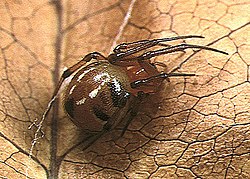Parasteatoda
Parasteatoda is a genus of comb-footed spiders that was first described by Allan Frost Archer in 1946.[2] The name is a combination of the Ancient Greek "para-" (παρά), meaning "near" or "next to", and the theridiid genus Steatoda. The Japanese name for this genus is O-himogumo zoku ("thread silk spider family").[3]
| Parasteatoda | |
|---|---|

| |
| P. japonica, female | |

| |
| P. japonica, male | |
| Scientific classification | |
| : | [[Template:Taxonomy/Parasteatoda]] Archer, 1946[1] |
| Type species | |
| P. tepidariorum (C. L. Koch, 1841)
| |
| Species | |
|
42, see text | |
SpeciesEdit
It is mostly an Old World genus, with many species found in Asia and New Guinea, though the distribution reaches into Europe. A few species originate from the New World, but many have been introduced, and they are becoming more widespread in the Americas and Europe.[3]
As of May 2020[update] it contains forty-two species and two subspecies:[1]
- Parasteatoda aequipeiformis Yang, Irfan & Peng, 2019 – China
- Parasteatoda angulithorax (Bösenberg & Strand, 1906) – Russia (Far East), China, Korea, Japan
- Parasteatoda asiatica (Bösenberg & Strand, 1906) – China, Korea, Japan
- Parasteatoda camura (Simon, 1877) – Philippines, New Guinea, Solomon Is.
- Parasteatoda celsabdomina (Zhu, 1998) – India, China, Thailand, Laos
- Parasteatoda cingulata (Zhu, 1998) – China
- Parasteatoda corrugata Yoshida, 2016 – Japan
- Parasteatoda culicivora (Bösenberg & Strand, 1906) – China, Japan
- Parasteatoda daliensis (Zhu, 1998) – China, Laos
- Parasteatoda decorata (L. Koch, 1867) – Indonesia (Krakatau), New Guinea, Australia (Queensland)
- Parasteatoda ducta (Zhu, 1998) – China
- Parasteatoda galeiforma (Zhu, Zhang & Xu, 1991) – China
- Parasteatoda gui (Zhu, 1998) – China
- Parasteatoda hammeni (Chrysanthus, 1963) – New Guinea
- Parasteatoda hatsushibai Yoshida, 2009 – Japan
- Parasteatoda jinghongensis (Zhu, 1998) – China
- Parasteatoda kaindi (Levi, Lubin & Robinson, 1982) – New Guinea
- Parasteatoda kentingensis Yoshida, 2015 – Taiwan
- Parasteatoda kompirensis (Bösenberg & Strand, 1906) – India, China, Korea, Japan
- Parasteatoda lanyuensis (Yoshida, Tso & Severinghaus, 2000) – Taiwan
- Parasteatoda longiducta (Zhu, 1998) – China
- Parasteatoda lunata (Clerck, 1757) – Europe, Turkey, Israel, Caucasus, Russia (Europe to Far East), Iran
- Parasteatoda l. serrata (Franganillo, 1930) – Cuba
- Parasteatoda merapiensis Yoshida & Takasuka, 2011 – Indonesia (Java)
- Parasteatoda nigrovittata (Keyserling, 1884) – Mexico to Argentina
- Parasteatoda oxymaculata (Zhu, 1998) – China, India, Laos
- Parasteatoda palmata Gao & Li, 2014 – China
- Parasteatoda polygramma (Kulczyński, 1911) – New Guinea
- Parasteatoda quadrimaculata (Yoshida, Tso & Severinghaus, 2000) – Taiwan
- Parasteatoda ryukyu (Yoshida, 2000) – Japan, Ryukyu Is., Taiwan
- Parasteatoda simulans (Thorell, 1875) – Europe, Turkey, Caucasus, Russia (Europe to South Siberia)
- Parasteatoda songi (Zhu, 1998) – China
- Parasteatoda subtabulata (Zhu, 1998) – China
- Parasteatoda subvexa (Zhu, 1998) – China
- Parasteatoda tabulata (Levi, 1980) – Tropical Asia. Introduced to North America, Europe, Georgia, Russia (Europe to Far East), Central Asia, China, Korea, Japan
- Parasteatoda taiwanica Yoshida, 2015 – Taiwan
- Parasteatoda tepidariorum (C. L. Koch, 1841) (type) – South America. Introduced to Canada, USA, Seychelles, Europe, Turkey, Caucasus, Russia (Europe to Far East), Kazakhstan, Iran, Central Asia, China, Japan, New Zealand, Hawaii
- Parasteatoda t. australis (Thorell, 1895) – Myanmar
- Parasteatoda transipora (Zhu & Zhang, 1992) – China
- Parasteatoda triangula (Yoshida, 1993) – Singapore, Indonesia (Java, Bali)
- Parasteatoda valoka (Chrysanthus, 1975) – New Guinea, Papua New Guinea (New Britain)
- Parasteatoda vervoorti (Chrysanthus, 1975) – New Guinea
- Parasteatoda wangi Jin & Zhang, 2013 – China
- Parasteatoda wau (Levi, Lubin & Robinson, 1982) – New Guinea
Formerly included:
- P. brookesiana (Barrion & Litsinger, 1995) (Transferred to Nihonhimea)
- P. campanulata (Chen, 1993) (Transferred to Campanicola)
- P. ferrumequina (Bösenberg & Strand, 1906) (Transferred to Campanicola)
- P. japonica (Bösenberg & Strand, 1906) (Transferred to Nihonhimea)
- P. mundula (L. Koch, 1872) (Transferred to Nihonhimea)
- P. mundula (Chrysanthus, 1963) (Transferred to Nihonhimea)
- P. oculiprominens Saito, 1939 (Transferred to Keijiella)
- P. tesselata (Keyserling, 1884) (Transferred to Nihonhimea)
In synonymy:
- P. boqueronica (Kraus, 1955) = Parasteatoda nigrovittata (Keyserling, 1884)
- P. krausi (Chrysanthus, 1963) = Parasteatoda camura (Simon, 1877)
- P. lunata (Olivier, 1789) = Parasteatoda lunata (Clerck, 1757)
- P. mesax Levi, 1959 = Parasteatoda nigrovittata (Keyserling, 1884)
- P. nipponica (Yoshida, 1983) = Parasteatoda tabulata (Levi, 1980)
- P. obnubila (Keyserling, 1891) = Parasteatoda nigrovittata (Keyserling, 1884)
- P. pallida (Walckenaer, 1841) = Parasteatoda tepidariorum (C. L. Koch, 1841)
See alsoEdit
ReferencesEdit
- ↑ 1.0 1.1 Gloor, Daniel; Nentwig, Wolfgang; Blick, Theo; Kropf, Christian (2020). "Gen. Parasteatoda Archer, 1946". World Spider Catalog Version 20.0. Natural History Museum Bern. doi:10.24436/2. Retrieved 2020-06-30.
- ↑ Archer, A. F. (1946). "The Theridiidae or comb-footed spiders of Alabama". Museum Paper, Alabama Museum of Natural History. 22: 1–67.
- ↑ 3.0 3.1 Yoshida, H. (2008). "A revision of the genus Achaearanea (Araneae: Theridiidae)". Acta Arachnologica. 57: 37–40. doi:10.2476/asjaa.57.37.
Further readingEdit
- Song, D. X.; Zhu, M. S.; Chen, J. (1999). The Spiders of China. Hebei Science and Technology Publishing House, Shijiazhuang. p. 640.
- Zhu, M. S. (1998). Fauna Sinica: Arachnida: Araneae: Theridiidae. Science Press, Beijing. p. 436.
- Yin, C. M.; et al. (2012). Fauna Hunan: Araneae in Hunan, China. Hunan Science and Technology Press, Changsha. p. 1590.
- Yoshida, H. (2009), "Uloboridae, Theridiidae, Ctenidae", in Ono, H. (ed.), The spiders of Japan with keys to the families and genera and illustrations of the species